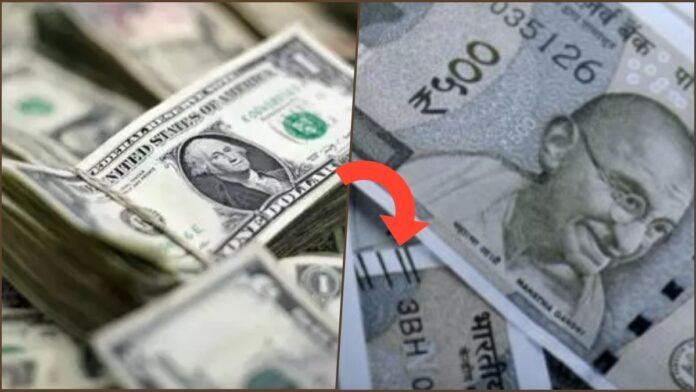
Key Points:
- Rupee Weakens Further: The Indian rupee fell by 21 paise to close at ₹86.61 against the US dollar in the interbank foreign exchange market.
- Key Drivers of Decline: The drop was attributed to the strengthening US dollar, rising crude oil prices, and foreign fund outflows.
- Dollar Index on the Rise: The dollar index, which measures the greenback’s strength against six major currencies, climbed 0.05% to 108.97.
- Market Volatility: Positive domestic stock markets provided minor support, but geopolitical uncertainties and fluctuating crude prices continue to exert pressure.
- Global Context: Analysts predict ongoing volatility in both the dollar and crude oil markets, especially ahead of the transfer of power to Donald Trump in the US next week.
New Delhi: The Indian rupee extended its losses on Thursday, closing at ₹86.61 against the US dollar, marking a 21 paise drop from its previous close. This decline comes amid a strengthening greenback, increased crude oil prices, and persistent foreign fund outflows.
Intraday Performance
- Opening and Highs: The rupee opened at ₹86.42 in the interbank forex market and touched an intraday high of ₹86.37.
- Closing Price: It ended the session at ₹86.61, significantly lower than the previous day’s close of ₹86.40.
Factors Driving the Rupee’s Decline
- Strengthening US Dollar:
- The dollar index, which tracks the US dollar’s performance against six major global currencies, rose by 0.05% to 108.97.
- The dollar gained momentum due to geopolitical concerns and expectations of robust economic data from the US.
- Rising Crude Oil Prices:
- Brent crude futures, the global oil benchmark, fell marginally by 0.12% to $81.93 per barrel.
- Despite the dip, elevated crude prices continue to weigh on the rupee as India is a major importer of crude oil.
- Foreign Fund Outflows:
- Persistent outflows by Foreign Institutional Investors (FIIs) added to the pressure on the rupee.
- Geopolitical Uncertainty:
- Concerns over global political stability, particularly with the impending transfer of power to Donald Trump in the US, have added to market volatility.
Domestic Markets Offer Some Respite
Despite the rupee’s decline, positive domestic stock market performance helped cushion the fall to some extent. The BSE Sensex and NSE Nifty posted gains, reflecting investor optimism in the Indian economy.
Market Outlook
- Volatility Ahead:
Analysts predict continued fluctuations in the currency and crude oil markets due to global geopolitical uncertainties and inflationary pressures. - Focus on Policy Changes:
Traders are closely watching potential shifts in US policies after Trump’s assumption of office next week, which could further impact global markets.
The rupee’s recent slide to ₹86.61 highlights the challenges posed by global economic conditions, including a strengthening US dollar and rising crude oil prices. While positive trends in domestic equity markets offer some hope, continued volatility in global markets suggests that the rupee’s path ahead may remain uncertain. All eyes are now on the upcoming policy shifts in the US and their potential impact on global financial stability.













































